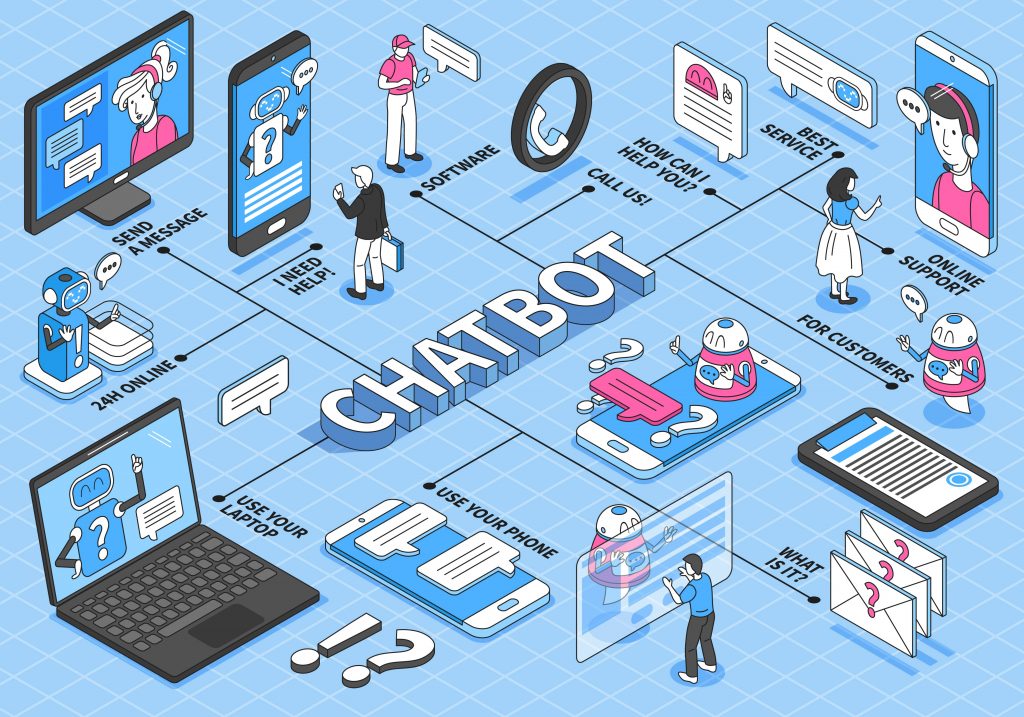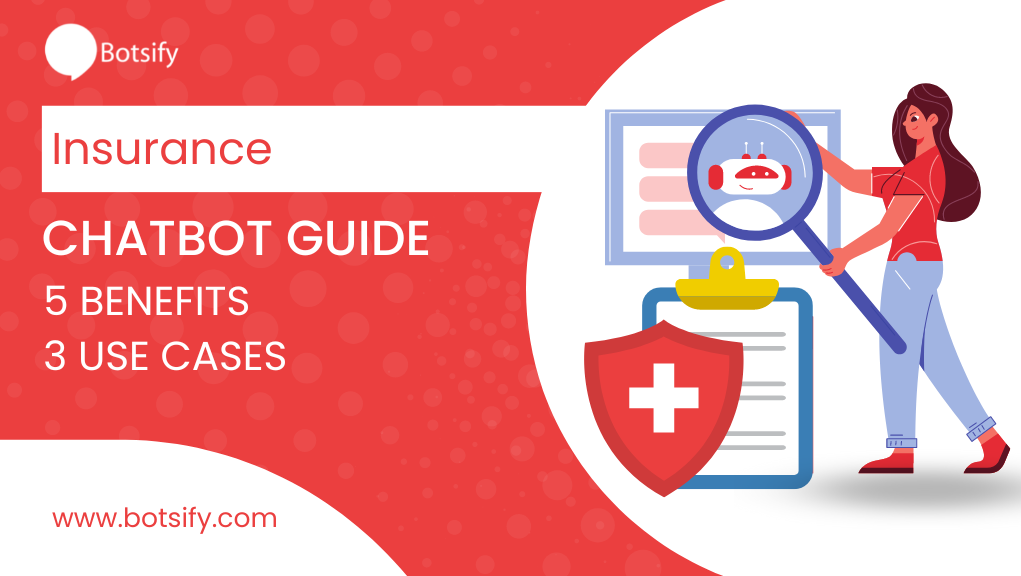The popularity of AI chatbots is growing at an ever-increasing rate. It’s everywhere, from Google’s Alexa and Apple’s Siri on your smart gadgets to chatbots in banking accounts, the list goes on. Every business and industry is now looking for ways to take advantage of AI in order to stay competitive and offer their customers the best experience possible.
Of course, insurance companies are no exception.
While the insurance industry wasn’t the first to innovate, changes were inevitable. First, since the pandemic, people’s expectations have skyrocketed, imposing the need on businesses to improve customer support service.
And secondly, the industry itself has witnessed an incredible rise in popularity. All of this has led to the need to use new ways of interacting with customers, and chatbots have responded to those needs perfectly.
What Is an Insurance Chatbot?
An insurance chatbot is what it says on the tin. It’s a virtual assistant programmed to facilitate communication between the insurance company and customers. There are two types of chatbots that insurance companies can use. They are:
- Rule-based;
- AI-powered
Rule-based chatbots, as the name suggests, can do a certain number of commands based on a set of predefined rules. Most often, they are used on FAQ pages to answer simple user questions.
AI-powered chatbots, in turn, are more advanced in the sense that they can not only answer frequently asked questions but actually understand intent.
Aside from that, they can process both text and pictures thanks to machine learning technologies. As a result, they can interact with customers through various means of communication, including audio, text, and instant messaging, and can also answer questions that have never been asked before.
Most often, conversational AI “lives” on specially designated pages of websites and applications, such as FAQs or knowledgeable bases. But as they get smarter and smarter, it’s not uncommon to see them being used in messaging apps like WhatsApp, Facebook Messenger, etc.
5 Benefits of Insurance Chatbots
Despite the complexity that the insurance sector entails, people still insure everything. However, unlike a few years ago, now they have become a lot pickier and only opt for insurers that keep things simple. That’s where AI chatbots come into play.

Insurance chatbots help ease user journey by:
- Breaking down lengthy policy documents into easy-to-understand, interactive forms;
- Providing price quotes and listing the company’s key strengths.
As a result, customers have an opportunity to evaluate coverage policies and make informed decisions without a steep learning curve.
What’s more, by closely monitoring user behavior and analyzing data, insurers themselves can identify gaps and optimize internal processes to quickly fix them.
Now, let’s take a closer look at how insurers can benefit from AI-powered chatbots.
Dedicated Round-the-Clock Customer Support
Since accidents and claims can occur at any time of the day, insurance has always been considered a 24/7 service. And in order to intake all these claims, for many years, insurers relied on night call centers.
The appearance of conversational AI has changed the situation drastically. What could only be done by hundreds of people a decade ago, now can be done by artificial intelligence software alone.
Chatbots can respond to any questions at any hour. What’s more, they can recognize user intent and build effective real-time conversations with appropriate questions.
Based on responses, chatbots can refine policies, providing users with detailed information on existing options and pricing plans, and link them to a merchant (if necessary).
As a result, customers can avail the best experience possible. Insurance companies, in turn, can reduce operating expenses and focus on other facets of the business.
Simplification
While it may not seem like it, answering questions in the traditional way takes a lot of time and effort. Even routine customer inquiries that insurance companies respond to every day can turn into long conservations, slowing down the workflow of the whole team.
Add to this a slew of calls with handoffs, and you can see how busy yet non-productive an employee’s day can be.
Chatbots streamline internal complexities. By asking the right questions, they can predict what customers need and provide them with the best options.
What’s more, they can learn at what stage the case becomes complicated and hand it over to a human agent. As a result, insurers have a chance to offload their employees and reach a higher level of productivity.
Generate Leads
Artificial intelligence virtually feeds on information. From introductory messages where users are required to identify themselves to more specific dialogues, chatbots collect and store data at all times.
Thanks to this, insurance companies gain access to valuable data that can help them determine:
- Who the majority of their customers is;
- What issues do they have;
- What happened in their clients’ lives;
- How customer needs have changed;
- The potential demand for new insurance products.
When they have this information, they can further decide how to improve their output.
Most often, companies choose to automate the data collection process with a chatbot, thus reducing human involvement to a minimum. However, traditional engagement methods, including static web forms, are still being used. This helps reach a wider audience and collect more data, as well as assess what percentage of users prefer communication with AI.
Reduce Costs
While the cost of developing a chatbot isn’t exactly cheap, it’s much cheaper than hiring a department of personnel. First, AI chatbots don’t need to be paid for overnight shifts or vacations. They are always there for you, 27/4. Second, they can be used across multiple channels, including:
- Facebook;
- WhatsApp;
- Viber;
- Website;
- Email;
- Text;
- Slack.
This means policyholders can get support through any of the channels they are most used to, without the need for live agents to be there. On top of that, AI can detect fraud. All this helps reduce costs and eliminate costly errors and allows insurers to improve their efficiency when selling insurance.
Multilingual Support
Last but not least, with multilingual insurance chatbots, companies can erase barriers, talking to customers in a language they better understand. This capability not only gives the insurer an upper hand over the competition but also further reduces costs.
In addition, multilingual customer service allows companies to increase loyal customers and reach far beyond the local market.
3 Use Cases for AI Chatbots in the Insurance Sector
Now that we’ve covered the benefits of insurance chatbots, let’s move on to their practical uses.
As you can see, AI provides insurers with a powerful insight into user behavior based on the data it constantly collects. Best of all, the learning ability of insurance chatbots only improves over time, opening up a whole scope of potential applications.
With this in mind, insurers should plan ahead for how they are going to use chatbots, especially at the outset.
Answer FAQs
As mentioned earlier, insurance is a rather complex and boring topic that a lot of people find difficult to understand. However, it is only so for those who don’t use AI. Companies that use chatbots to answer FAQs attract more users and have better user acquisition overall.
Since AI chatbots use natural language processing, they can see the user’s intent.
Thanks to this, they can not only explain some of the complex issues but also match users with effective solutions. As a result, insurers can deliver better customer service while minimizing the involvement of the team.
By using natural language processing, AI-powered chatbots can explain complex insurance issues and provide effective solutions to customers. This can improve customer service and minimize the involvement of the insurance team. Companies that offer insurance software development services can help insurers create chatbots tailored to their specific needs.
Onboard New Users and Members
Chatbots are also very good at helping familiarize new users with the insurer’s services. They can help communicate the benefits of a product. They can also serve as a prompt, helping users sign up for wellness programs and/or choose the right policy. In addition, chatbots can answer common insurance questions, such as:
- How to pay bills;
- How to update information;
- How to file claims;
- How to download a digital ID card, and many more.
Essentially, conversational AI can guide the entire customer journey from start to finish, ensuring that no question is left unanswered.
The support of omnichannel capabilities is an added value of AI. Thanks to this, users can communicate with companies across various channels with no need to reproduce themselves. For companies, an omnichannel feature means they don’t lose customer conversations and have valuable data for improvements.
File Claims
Everyone who’s ever filed claims knows firsthand how complicated claim processing can be. In fact, it can even take months, not to mention the number of people that the process can involve. With chatbots, however, the entire file management has been made simpler.
Instead of spending weeks completing paperwork, it’s enough to report the claim. Once the virtual assistant has received the information and searches for the relevant policy, it will automatically file a claim on a customer’s behalf.
Aside from that, AI-powered chatbots can assess the insurance type for its eligibility based on the media provided by customers along with supportive documents. In the event of enough proof, chatbots can verify the damage and determine liabilities.
Finally, with the help of AI, insurance companies can send their customers notifications about extreme weather events. Thanks to this, people can get prepared for an event in advance and take the right actions. This also helps solve a few issues:
- Free up contact centers;
- Minimize losses for clients, effectively resulting in fewer new claims.
Conclusion
In accordance with Avenga.com, as evident from the trends, the use of conversational AI in the insurance sector is only going to increase. From providing guidance and answering common questions to automatically initiating a claim filing, chatbots can do all that and more. The next step of the development that we’re likely to see is expanding AI chatbots’ capabilities.
While a lot of chatbots used today perform the functions of a mediator, very soon, most of them will turn into advisors. Some will even get the capabilities of voice assistants similar to Siri and Alexa. And it won’t take long before technologies like IoT and blockchain make their way into insurance AI-powered insurance chatbots.
Even as is, the impact of AI technology and chatbots is huge. Things that were hard to understand a decade ago have become accessible, resulting in an increase in the demand for insurance products.
Companies, on the other hand, have received a powerful tool that generates leads and collects data. As a result, they can better understand what exactly their customers want and engage with them in a more personalized way.
All in all, conversational AI is a great addition to a business strategy for insurers and the only way to stay competitive in the market.

